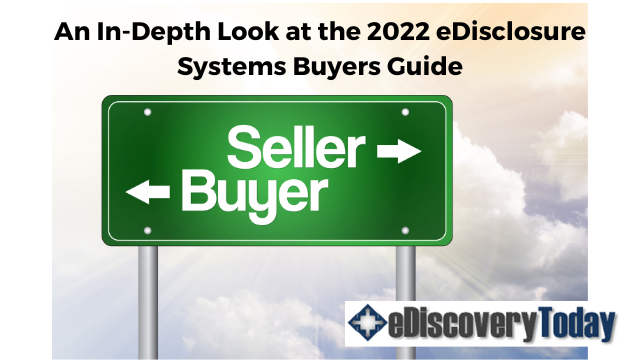

Last week on eDiscovery Today, I covered Andrew Haslam’s annual eDisclosure Systems Buyers Guide, which was published last week on Rob Robinson’s ComplexDiscovery site here. As you can imagine, it’s difficult to cover a 450-page guide like that in-depth in a single blog post. So, I’m taking the next two posts here on this blog to take a more in-depth look at the guide and some of the other benefits of it.
…[b]ecause so much of the software in this area comes from the United States, it is as well to recognise the synonym eDiscovery, which is the American term for eDisclosure.
Doug Austin quoting Andrew Haslam
Educational Resources
While the bulk of the terrific 450-page guide is dedicated to a detailed look at service and software providers (what Andrew calls “Suppliers” and “Software”), the first 70+ pages is mostly dedicated to educational resources. Here are a few of the resources Andrew discusses:
eDisclosure – An Introduction: This is the very basic definition of eDisclosure, which as Andrew states, is “The definition of eDisclosure then becomes the process of identifying, collecting, processing, analysing, reviewing and presenting ESI for legal proceedings.” Sounds familiar! Oh, and “[b]ecause so much of the software in this area comes from the United States, it is as well to recognise the synonym eDiscovery, which is the American term for eDisclosure.”
EDRM Model: Andrew follows up on his definition of eDisclosure with a detailed discussion of the EDRM model, going through each box of the model and looking at three things: Description-The official description of the individual process/procedure; Legal Implications-What you as a lawyer might become involved in within this particular process; and Who can help-A brief overview of the types of services and/or software products you might need to support you in this process.
Andrew also uses his terrific conventions of “Note”, “Best Practice” and “Warning” to illustrate important points throughout. For example:
- In his discussion of Information Governance, Andrew provides a Note that says: There’s a BD opportunity here – Why not approach your clients (possibly with a technology partner by your side) and engage them in conversations about becoming litigation ready. You supply the detailed legal and business specific knowledge and the client is better prepared for the “evil day” of litigation.
- In his discussion of Identification, Andrew provides a Best Practice that says: Build a “Data Map” as soon as possible – Should be a single piece of A4 that describes where the data is stored and any issues surrounding it. Print it out and have it on the front of the Matter file. The overall concept of a “Data Map” is embodied in Section 2 of the DRD (Disclosure Review Document).
- In his discussion of Preservation, Andrew provides a Warning that says: Forget the Client’s IT staff at your peril – Make sure the Client’s IT people understand what data you are preserving, so that they don’t inadvertently destroy it as part of their normal business practice.
Cooperation in England and Wales: Andrew discusses the importance of emphasising the focus on cooperation for the eDisclosure process within England and Wales, providing important “Practice Direction” references, while noting that “Cooperation is not collaboration.”
Technology Areas: Here, Andrew aims to “provide a brief outline of the various areas of technology in order to provide context for the rest of the Guide”. After all, you can’t be an informed buyer without understanding what you’re buying, right? So, Andrew discusses areas here, including:
- Litigation Readiness / RIM / Email Archiving
- Collection – Forensic & Generic
- Scanning (because paper documents still exist)
- Objective & Subjective Coding
- Litigation Support Tools, including: Early Case/Data Assessment, Litigation Support Systems and Multi-Purpose Tools
- Presentation Systems
Andrew’s eDisclosure Systems Buyers Guide is not just the most comprehensive resource for learning about the service and software providers in the market, it’s also a terrific resource to educate the buyer on eDisclosure/eDiscovery best practices and technology. Next time, I’ll cover his discussions around “market survey”, “procurement approach” and “additional resources”. You can check out his guide via ComplexD here!
Experience more of Doug Austin’s great work at the eDiscovery Today blog here.
Follow Doug Austin on JD Supra here.
Follow EDRM on JD Supra here.


